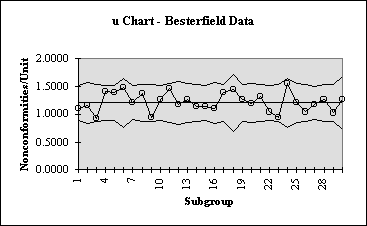
Attribute control charts arise when items are compared with some standard and then are classified as to whether they meet the standard or not. The control chart is used to determine if the rate of nonconforming product is stable and detect when a deviation from stability has occurred. The argument can be made that a LCL should not exist, since rates of nonconforming product outside the LCL is in fact a good thing; we WANT low rates of nonconforming product. However, if we treat these LCL violations as simply another search for an assignable cause, we may learn for the drop in nonconformities rate and be able to permanently improve the process.
The u Chart is used when it is not possible to have an inspection unit of a fixed size (e.g., 12 defects counted in one square foot), rather the number of nonconformities is per inspection unit where the inspection unit may not be exactly one square foot…it may be an intact panel or other object, different in size than exactly one square foot. When it is converted into a ratio per square foot, or some other measure, it may be controlled with a u chart. Notice that the number no longer has to be integer as with the c chart.
Steps in Constructing a u Chart
- Find the number of nonconformities, c(i) and the number of inspection units, n(i), in each sample i.
- Compute u(i)=c(i)/n(i)
- Determine the centerline of the u chart:
- The u chart has individual control limits for each subgroup i.
- Plot the centerline, ubar, the individual LCL’s and UCL’s, and the process measurements, u(i).
- Interpret the control chart.


Example:
Besterfield Example:
data is from Besterfield (1990): Quality Control p. 185
Number Nonconformities
Day Number Non- Per
Inspected Conformities Unit
1 110 120 1.0909
2 82 94 1.1463
3 96 89 0.9271
4 115 162 1.4087
5 108 150 1.3889
6 56 82 1.4643
7 120 143 1.1917
8 98 134 1.3673
9 102 97 0.9510
10 115 145 1.2609
11 88 128 1.4545
12 71 83 1.1690
13 95 120 1.2632
14 103 116 1.1262
15 113 127 1.1239
16 85 92 1.0824
17 101 140 1.3861
18 42 60 1.4286
19 97 121 1.2474
20 92 108 1.1739
21 100 131 1.3100
22 115 119 1.0348
23 99 93 0.9394
24 57 88 1.5439
25 89 107 1.2022
26 101 105 1.0396
27 122 143 1.1721
28 105 132 1.2571
29 98 100 1.0204
30 48 60 1.2500
Calculations:
UBAR = 1.2005
UCL = ubar + 3*sqrt(ubar/n(i))
LCL = ubar - 3*sqrt(ubar/n(i))
Day CL UCL LCL Nonconformities/Unit
1 1.2005 1.513900448 0.887091405 1.09
2 1.2005 1.563485937 0.837505915 1.15
3 1.2005 1.535975424 0.865016429 0.93
4 1.2005 1.507011595 0.893980258 1.41
5 1.2005 1.51678903 0.884202823 1.39
6 1.2005 1.639741695 0.761250158 1.46
7 1.2005 1.500557911 0.900433942 1.19
8 1.2005 1.532534517 0.868457335 1.37
9 1.2005 1.525958845 0.875033008 0.95
10 1.2005 1.507011595 0.893980258 1.26
11 1.2005 1.550892833 0.850099019 1.45
12 1.2005 1.59059276 0.810399092 1.17
13 1.2005 1.537736483 0.86325537 1.26
14 1.2005 1.524375074 0.876616779 1.13
15 1.2005 1.509712226 0.891279627 1.12
16 1.2005 1.55702269 0.843969162 1.08
17 1.2005 1.527566079 0.873425774 1.39
18 1.2005 1.707693252 0.693298601 1.43
19 1.2005 1.534241668 0.866750185 1.25
20 1.2005 1.543190862 0.857800991 1.17
21 1.2005 1.529197361 0.871794491 1.31
22 1.2005 1.507011595 0.893980258 1.03
23 1.2005 1.530853298 0.870138554 0.94
24 1.2005 1.635871613 0.76512024 1.54
25 1.2005 1.548918751 0.852073102 1.20
26 1.2005 1.527566079 0.873425774 1.04
27 1.2005 1.498088223 0.90290363 1.17
28 1.2005 1.521275681 0.879716172 1.26
29 1.2005 1.532534517 0.868457335 1.02
30 1.2005 1.674935581 0.726056271 1.25
u – Chart:
